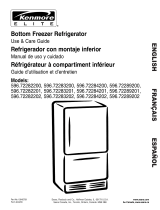
4
Product record
In the space below record the model
and serial numbers and purchase date
of your refrigerator. You will find the
model and serial number sticker inside
the refrigerator section on the left wall.
Model Number: 596. _______________
Serial Number: ____________________
Purchase Date: ____________________
Keep this booklet and your Sears
sales receipt in a safe place for future
reference.
Reverse Osmosis
Water Systems
Some Reverse Osmosis home
water systems cause low water
pressure. Low water pressure
can affect the water and ice
dispensing system by causing
small or hollow ice cubes and
slow water flow from the
dispenser. Service problems
related to the home’s Reverse
Osmosis water system are not
covered by the warranty.
Warranty
One Year Limited Warranty
When installed, operated and
maintained according to all
instructions supplied with the
product, if this appliance fails due to
a defect in material or workmanship
within one year from the date of
purchase, call 1-800-4-MY-HOME
®
to arrange for free repair.
If this appliance is used for other
than private family purposed, this
warranty applies for only 90 days
from the date of purchase.
This warranty covers only defects
in material and workmanship.
Sears will NOT pay for:
1. Expendable items that can wear
out from normal use, including
but not limited to filters, belts,
light bulbs, and bags.
2. A service technician to instruct
the user in correct product
installation, operation or
maintenance.
3. A service technician to clean or
maintain this product.
4. Damage to or failure of this
product if it is not installed,
operated or maintained according
to all instructions supplied with
the product.
5. Damage to or failure of this
product resulting from accident,
abuse, misuse or use for other
than its intended purpose.
6. Damage to or failure of this
product caused by the use of
detergents, cleaners, chemicals
or utensils other than those
recommended in all instructions
supplied with the product.
7. Damage to or failure of parts or
systems resulting
from unauthorized modifications
made to this
product.
Disclaimer of implied warranties;
limitation of remedies
Customer’s sole and exclusive
remedy under this limited warranty
shall be product repair as provided
herein. Implied warranties, including
warranties of merchantability or
fitness for a particular purpose, are
limited to one year or the shortest
period allowed by law. Sears shall
not be liable for incidental or
consequential damages. Some
states and provinces do not allow
the exclusion or limitation of
incidental or consequential
damages, or limitations on the
duration of implied warranties or
merchantability or fitness, so these
exclusions or limitations may not
apply to you.
This warranty applies only while this
appliance is used in the United
States and Canada.
This warranty gives you specific
legal rights, and you may also have
other rights which vary from state to
state.
Sears, Roebuck and Co., Dept.
817WA, Hoffman Estates, IL 60179
Sears Canada Inc., Toronto,
Ontario, Canada
M5B 2B8
Warranty























